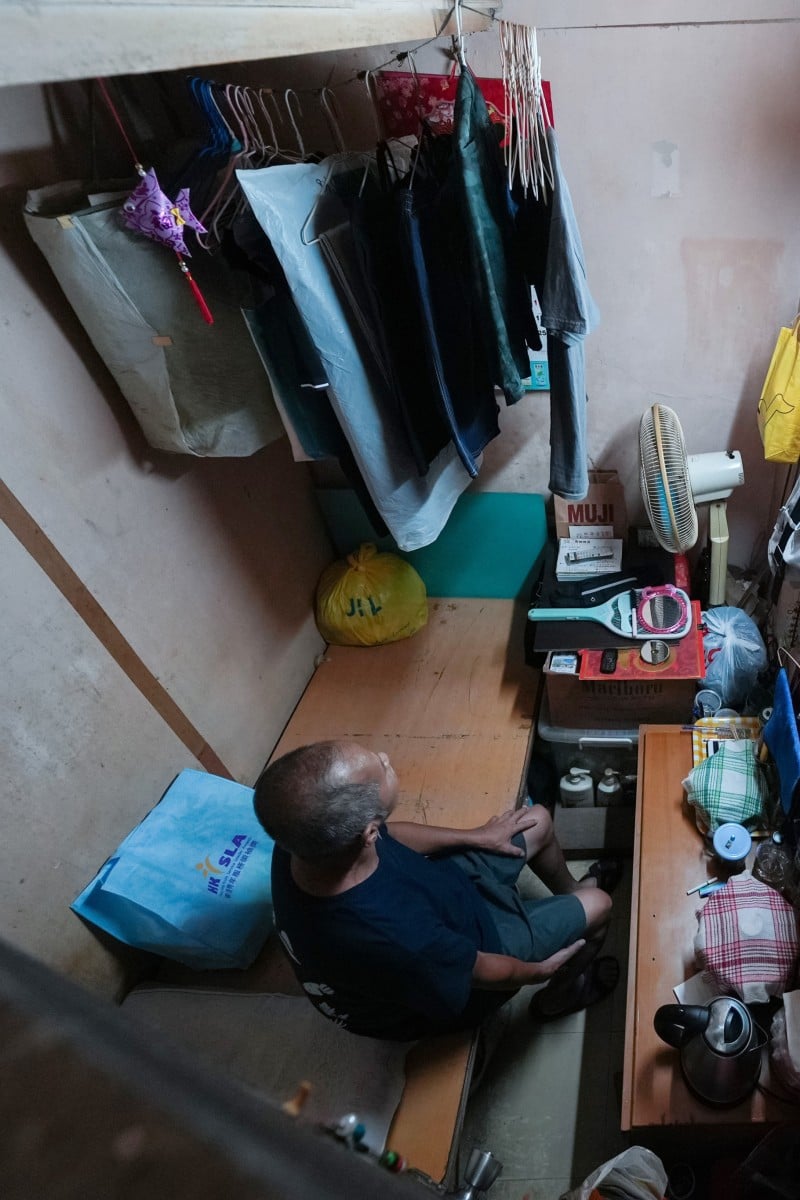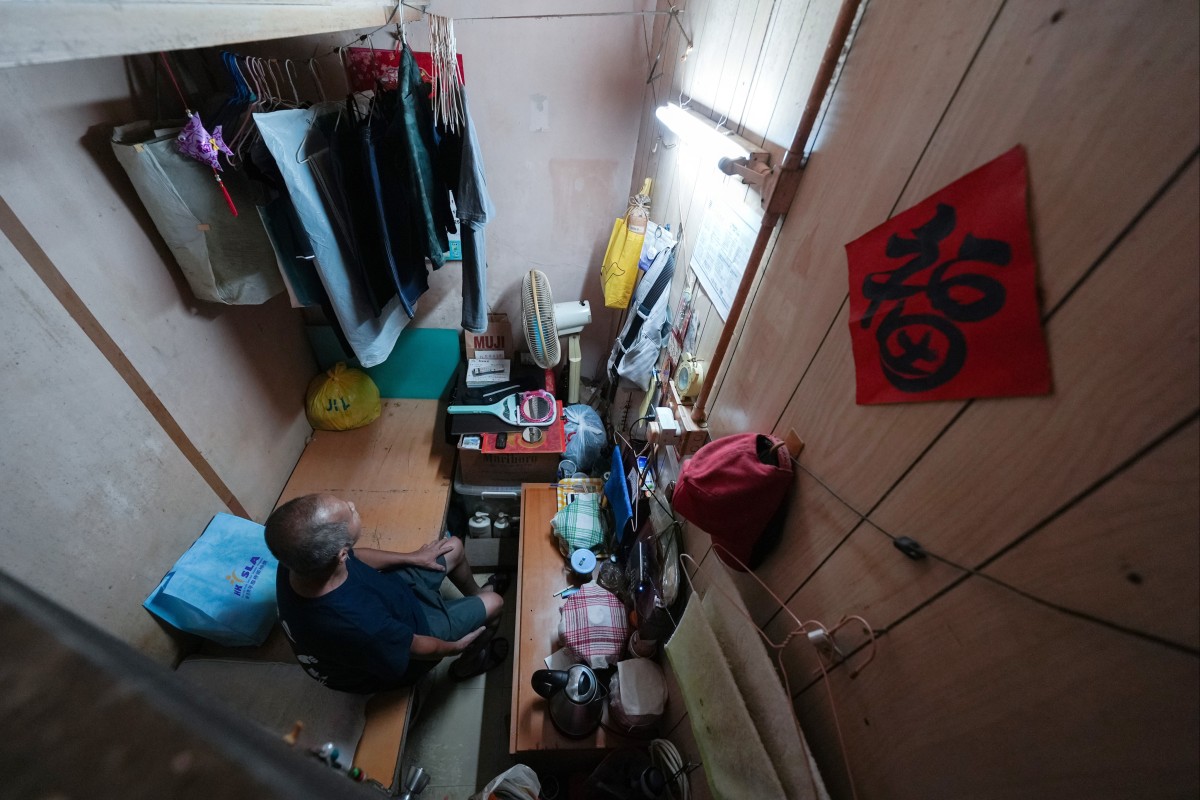
Spark Deep Dive: Hong Kong to launch scheme tackling subdivided flats
Chief Executive John Lee said in his policy address that a new law would create new standards for these units, but some have criticised the time frame.
 A 66-year-old man surnamed Choy, a semi-retired construction worker, sits in his 40 sq ft subdivided flat with no individual toilet in Sham Shui Po. The flat costs $2,400 per month. Photo: Eugene Lee
A 66-year-old man surnamed Choy, a semi-retired construction worker, sits in his 40 sq ft subdivided flat with no individual toilet in Sham Shui Po. The flat costs $2,400 per month. Photo: Eugene LeeDeep Dive delves into hot issues in Hong Kong and mainland China. Our easy-to-read articles provide context to grasp what’s happening, while our questions help you craft informed responses. Check sample answers at the end of the page.
News: Hong Kong announces new regulations for subdivided flats
-
Chief Executive John Lee said in his policy address that a new law would ensure minimum requirements for these units
-
Some have criticised the time frame and questioned what help the government would give tenants of substandard units
Hong Kong has set its sights on improving life for those in subdivided flats. Chief Executive John Lee Ka-chiu said in his recent policy address that a new law would make sure these flats met certain minimum requirements. These could include having proper windows, at least one toilet per unit and a minimum size of 86 sq ft.
According to official data, about 30 per cent of the city’s 110,000 subdivided homes do not meet these requirements. This equals about 33,000 flats. More than 20 per cent did not meet the minimum size requirement. Meanwhile, about 10 per cent failed to meet other existing standards, a government source said.
Under the new scheme, owners will be required to register their subdivided flats. They will be given a grace period to carry out improvement works. They must then be checked by professionals for the home to qualify as a basic housing unit.
Lee said the registration period could be 12 to 18 months. It will be followed by a grace period of one to two years. The policy is expected to be passed by the Legislative Council next year. An insider said authorities may need about four years to tackle the problem.
Those living in substandard flats would likely be forced to move under the new policy. Lee said those people could eventually consider renting “basic housing units”. This is the government’s term for subdivided flats renovated to meet the new standards.
Lai Yuen-shan is an assistant professor at the department of sociology and social policy at Lingnan University. She said she expected the government to reveal more details about how it would enforce the scheme and supporting measures such as rent control.
“I am concerned about how the government will arrange resettlement measures for affected tenants to ensure their transition to transitional housing and other accommodation,” Lai said. She added that the government could give people money to help them move.
Lai also asked whether the government would limit the rent landlords could charge for the renovated subdivided flats. This would make sure residents would not pay a lot more money to “compensate” for the expense.
Angela Lui Yi-shan is a community organiser with the Society for Community Organisation. She believed the government’s proposed processing time was too long. “Four years to implement the new measure is longer than our expectation,” she said.
Question prompts
1. Which of the following statements is true based on the news?
(1) Around 33,000 flats do not meet the new minimum requirements for subdivided units.
(2) The entire process of implementing and enforcing the measures would take around four years.
(3) The new policy does not mention needing a toilet in the flat.
(4) The new standards include a minimum size of 100 sq ft.
A. (1), (2) only
B. (1), (3) only
C. (2), (3) only
D. (2), (4) only
2. According to the news and your own knowledge, what obstacles would make it difficult to carry out this proposal?
3. Using the news, list TWO ways the new rules for subdivided flats could affect the people living in them.
Comic
Question prompts
1. What message about housing in Hong Kong is the artist portraying?
2. Using the news and your own knowledge, what other issues related to money and housing are depicted in the cartoon?
Glossary
subdivided flats: flats that have been divided into two or more separate units to house more people. They are typically quite small and aimed at lower-income residents.
policy address: a yearly speech given by Hong Kong’s chief executive. It outlines the government’s plans for the year, covering areas such as the economy, education, and housing.
Legislative Council: also known as Legco, it is part of the Hong Kong government. The Legislative Council creates, changes and repeals laws. It also approves budgets and taxes and inspects the government’s policies and work.
grace period: a set length of time after a deadline in which there is no punishment for not following a law or rule.
Sample answers
News
1. A
2. It would be difficult to help tens of thousands of people move out of their homes for an undetermined amount of time. It is also unclear where they would go, as the government has not offered details on transitional housing. There has not been any information about a moving allowance either, and people may be unable to afford to move.
3. Tenants may be forced to leave their homes and uproot their lives. They would likely need rent control in their new homes, per Lai Yuen-shan, since many of these people are likely on a budget. Landlords may also try to charge more for renovated flats to compensate for their expenses, meaning tenants may end up paying more than they can afford.
Cartoon
1. This satirical comic highlights the poor standards for subdivided flats in Hong Kong. The man on the right lives in a flat the size of a box, and yet the man on the left – presumably an inspector – said this tiny home meets the minimum requirements. The comic portrays the terrible living situations many Hongkongers find themselves in and implies that the government is unconcerned about the issue. (accept all reasonable answers)
2. The man on the right appears to live in one of Hong Kong’s tiny subdivided flats – or even a coffin home – and probably does not earn much money. He has stuffed his belongings in the small space he calls home. Even though it is too small for a person to comfortably live in, the space has still been declared a “basic housing unit” by someone dressed in a suit who likely makes more money. The cartoon could reflect how people in positions of power, or those who have money, tell lower-income individuals that their situation is fine when it is unlikely they will face a similar one themselves. (accept all reasonable answers)